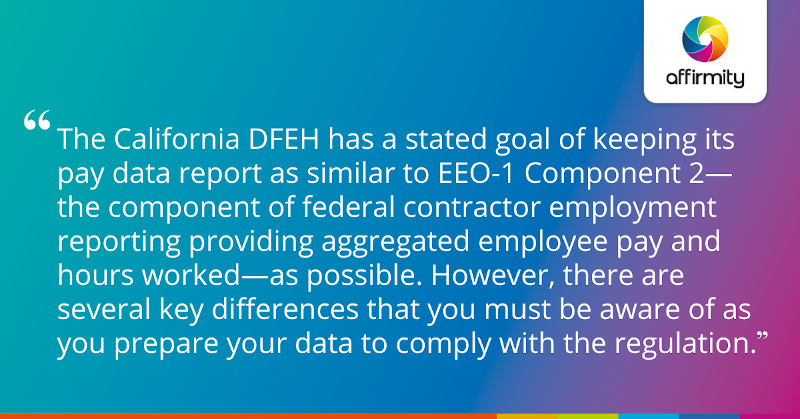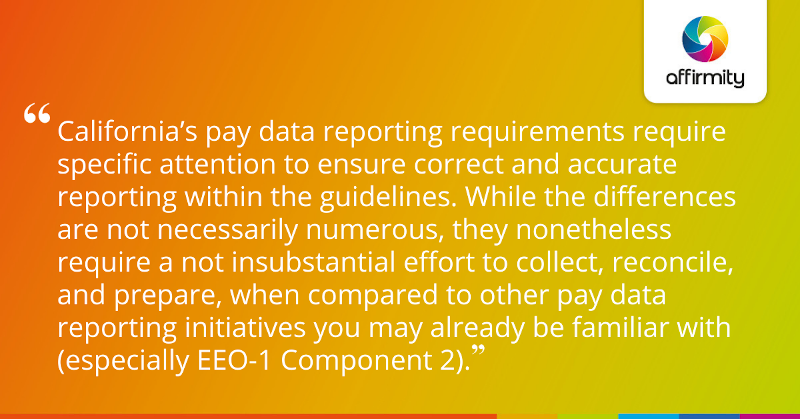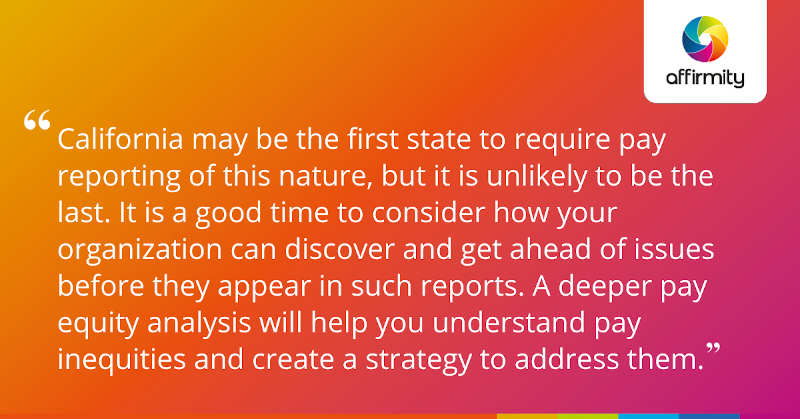Businesses above a certain size with employees based in California must now report employee pay data to California’s Department of Fair Equity and Housing (DFEH). Discover what the pioneering pay reporting bill (SB 973) means for your organization, the precedent set for other states, and how to prepare your report.
“You can’t fix what you can’t see,” says California State Senator Hannah-Beth Jackson, author of both the landmark 2015 California Pay Act and SB 973, a recently approved bill that makes the state the first in the US to report employee pay data to its DFEH. The bill defines March 31 the date on which every year, commencing in the first quarter of 2021, that companies operating in the US must file a California pay data report covering pay and demographic data.
The California DFEH has a stated goal of keeping its pay data report as similar to EEO-1 Component 2—the component of federal contractor employment reporting providing aggregated employee pay and hours worked—as possible.
However, there are several key differences that you must be aware of as you prepare your data to comply with the regulation. In this article, we’ve explored the requirements and nuances involved.
The Basics of California Pay Data Reporting (SB 973)
Before considering what makes SB 973 unique and the potential data challenges it presents, it would be beneficial to review the basics. The points below will help you determine whether your organization needs to report its pay data, and if so, what that report should look like. More information can be found on California’s DFEH website.

Who Has to File a Pay Data Report?
You must file a pay data report if:
- You are a private employer with at least 100 or more employees, and
- You have at least one employee who works in California or reports to a California-based establishment
Which Employees Need to Be Included in the Pay Data Report?
Employers only need to report on employees located in, or reporting to, California. However, organizations may optionally report against all employees. Employers should use a snapshot period between October 1 and December 31 of the reporting year to identify the employees to be reported on.
How Should Employee Pay and Demographics Be Categorized?
The pay report uses existing and familiar formats from other government agencies. Race and ethnicity reporting uses seven EEOC categories:
- White (not Hispanic or Latino)
- Black or African American (not Hispanic or Latino)
- Hispanic or Latino
- Asian (not Hispanic or Latino)
- American Indian/Alaskan Native (not Hispanic or Latino)
- Native Hawaiian or Other Pacific Islander (not Hispanic or Latino)
- Two or More Races (not Hispanic or Latino)
The categories combined with a sex grouping for a three-digit code—see page 63/64 of the user guide for a full list.
Job categories will follow the EEO-1 Job Classification Guide and pay bands will utilize those established by the U.S. Bureau of Labor Statistics.
What Period Should the Pay Data Report Cover?
The reporting year is the prior calendar year: so a report filed for March 31, 2021 will cover 2020, a report for March 31, 2022 will cover 2021, and so on.
Where Should Reports Be Submitted?
Reports must be filed by March 31 through the DFEH Pay Reporting Portal. There is no email or hardcopy submission option. Both single or multiple-establishment employers will have to submit a single report.
ALSO ON THE SUBJECT | ‘The 5-Step Plan to Embed Fair Pay Practices In Your Organization’

In What Ways Is California Pay Data Reporting Unique?
With the basics established, let’s consider how California’s pay data reporting requirements require specific attention to ensure correct and accurate reporting within the guidelines. While the differences are not necessarily numerous, they nonetheless require a not insubstantial effort to collect, reconcile, and prepare, when compared to other pay data reporting initiatives you may already be familiar with (especially EEO-1 Component 2).
- Unlike EEO-1 Component 2, salary information is to be collected from Box 5 of Form W2, rather than Box 1.
- California recognizes non-binary individuals alongside males and females for gender identification purposes (the guidance materials use ‘sex’ rather than ‘gender’ in their terminology). If the employee does not state their gender/sex, employers must assign a category using either current employment or other reliable records, or observer perception.
- Because the report is state-specific, employers will have to do additional work to determine which employees to include in the report (i.e. including only those physically located in California, or working remotely elsewhere but reporting to a California-based establishment).
- A corrected report should be filed whenever an employee’s W2 is updated resulting in their placement into a different pay band.
MORE FROM THE BLOG | ‘Tools and Strategies to Elevate Your Affirmative Action Program’
How to Collect Data for a California Pay Report
Above is an example output from DFEH (see page 16 of the user guide), using the spreadsheet template format it provides on its pay reporting hub. Note that in the example, the ‘establishment information’ section is truncated. Each line should include the following establishment information:
- Establishment name
- Establishment ID
- Establishment address line 1 and 2, city, state, and ZIP Code
- NAICS Code
- A description of the business’ major activity
- Total number of employees
- Yes/No statement of:
- Whether a California Pay Data Report was filed last year
- Whether an EEO-1 Report was filed last year
- Whether the establishment is the employer’s headquarters
Each line should then go on to include the following aggregate employee information:
- Employee job category (as per EEO-1 Job Classification Guide)
- Race/ethnicity/sex (three-digit EEO-1 code)
- Pay band (as per U.S. Bureau of Labor Statistics)
- Number of employees in the category the row describes
- Sum of hours worked in the category the row describes

Based on these requirements, most employers will likely need to collect data from at least two systems: their human resource management, and their payroll systems. A time-tracking system may also be involved if the hours an employee works aren’t captured in HRMS or payroll. This presents a potentially daunting challenge when faced with a relatively short deadline, especially for employers rapidly approaching the first quarter deadline each year.
LEARN MORE ABOUT DATA | ‘Do You Know Your Diversity Numbers? The Value of Intersectionality, Benchmarking, and Beyond’
Final Thoughts
California may be the first state to require pay reporting of this nature, but it is unlikely to be the last. With a trend likely to emerge in the years ahead, it is a good time to consider how your organization can discover and get ahead of issues before they appear in such reports. A deeper pay equity analysis will help you understand pay inequities and create a strategy to address them—helping you go above and beyond your compliance obligations.
Whether you are up against the deadline or not, outside assistance in the compilation and preparation of data is invaluable. Affirmity can assist: our consultants can help guide your data collection efforts and will then analyze, prepare the data and create the report for your review prior to submitting it to DFEH.
Want to discuss your submission to California’s DFEH or explore the possibilities of a full pay equity analysis with our dedicated, PhD-level workforce analytics team? Contact us today.
 About the Author
About the Author
Allen Appleby oversees product management at Affirmity with direct responsibility for establishing product vision, strategy, and roadmaps. He’s a seasoned product management leader who brings 20+ years of experience across multiple industries. He helps clients achieve positive business outcomes by ensuring Affirmity’s products deliver value across their affirmative action, EEO, and diversity and inclusion needs. Allen holds a Bachelor of Science in Business, an MBA in Marketing, and is Pragmatic Marketing certified.
